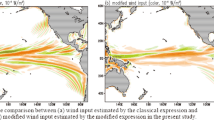Abstract
On the general ocean circulation forced by the asymmetric wind stress curl, the role of the eddies which are detached from the western boundary current is studied using an eddy-resolving two-layered quasi-geostrophic numerical model with free-slip boundary condition. An ideal sinusoidal function is used as the wind stress curl, and amplitude is assumed to be larger over the southern basin than over the northern one. In contrast with the antisymmetric wind forcing, in the asymmetric wind stress case, the subtropical western boundary current overshoots to the north from the zero wind stress curl line. As the asymmetricity of the wind forcing becomes larger, the separation point of the time mean field is located further north. The eddies generated in the region of the subtropical recirculation are advected northward by the western boundary current and they are detached from subtropical gyre. The release of these eddies to the north basin leads to weaken the subtropical recirculation system. From the analysis of the potential vorticity budgets, in the asymmetric case, it is shown that detached eddies play an important role in transporting the negative vorticity which is excessively inputted into the southern basin, to the northern basin, in addition to the terms which transport vorticity in the antisymmetric case, i.e., the vorticity transport by the meander of the jet. Under the free-slip boundary, more than a quarter of that excess vorticity is transported by those detached eddies in some cases.
Similar content being viewed by others
References
Barnier, B., B. L. Hua and C. Le Provost (1991): On the catalytic role of high barotropic modes on eddy-driven large-scale circulation.J. Phys. Oceanogr.,21, 976–997.
Dengg, J. (1993): The problem of Gulf Stream Separation: A barotropic approach.J. Phys. Oceanogr.,23, 2182–2200.
Haidvogel, D. B., J. C. McWilliams and P. R. Gent (1992): Boundary current separation in a quasi-geostrophic, eddy-resolving ocean circulation model.J. Phys. Oceanogr.,22, 882–902.
Harrison, D. E. and W. R. Holland (1981): Regional eddy vorticity transport and the equilibrium vorticity budgets of a numerical model ocean circulation.J. Phys. Oceanogr.,11, 190–208.
Harrison, D. E. and S. Stalos (1982): On the wind-driven ocean circulation.J. Mar. Res.,40, 773–791.
Holland, W. R. (1978): The role of mesoscale eddies in the general circulation of the ocean.J. Phys. Oceanogr.,8, 363–392.
Holland, W. R. and P. B. Rhines (1980): An example of eddy-induced ocean circulation.J. Phys. Oceanogr.,10, 1010–1031.
Holland, W. R. and W. J. Schmitz, Jr. (1985): Zonal penetration scale of model midlatitude jets.J. Phys. Oceanogr.,15, 1859–1875.
Kutsuwada, K. and T. Teramoto (1987): Monthly maps of surface wind stress fields over the North Pacific during 1961–1984.Bull. Ocean Res. Inst., University of Tokyo,24, 100 pp.
Le Provost, C. and J. Verron (1987): Wind driven midlatitude jet: Transition to barotropic instability.Dyn. Atmos. Oceans,11, 175–201.
Lozier, M. S. and S. C. Riser (1990): Potential vorticity sources and sinks in a quasi-geostrophic ocean: beyond western boundary currents.J. Phys. Oceanogr.,20, 1608–1927.
Marshall, J. (1984): Eddy-mean flow interaction in a barotropic ocean model.Quart. J. Roy. Meteor. Soc.,110, 573–590.
Nilsson, C. S. and G. R. Cresswell (1981): The formation and evolution of East Australian Current warm-core eddies.Prog. Oceanogr.,9, 133–183.
Olson, D. B. (1991): Rings in the ocean.Ann. Rev. Earth Planet. Sci.,19, 283–311.
Rhines, P. B. and R. Schopp (1992): The wind-driven circulation: Quasi-geostrophic simulations and theory for nonsymmtric winds.J. Phys. Oceanogr.,21, 1438–1469.
Richardson, P. L. (1983): Gulf Stream rings. p. 19–45. In:Eddies in Marine Science, ed. by A. R. Robinson, Berlin: Springer-Verlag.
Schmitz, W. J., Jr. and W. R. Holland (1986): Observed and modeled mesoscale variability near the Gulf Stream and Kuroshio Extension.J. Geophys. Res.,91, 9624–9638.
Veronis, G. (1966): Wind driven ocean circulation: Part 2. Numerical solutions of the non-linear problem.Deep-Sea Res.,13, 31–55.
Verron, J. and C. Le Provost (1991): Response of eddy-resolved general circulation numerical models to asymmetrical wind forcing.Dyn. Atmos. Oceans,15, 505–534.
Author information
Authors and Affiliations
Rights and permissions
About this article
Cite this article
Yasuda, T., Hanawa, K. Influence of asymmetric wind stress curl on the general ocean circulation using an eddy-resolving quasi-geostrophic model. J Oceanogr 52, 189–206 (1996). https://doi.org/10.1007/BF02235669
Received:
Revised:
Accepted:
Issue Date:
DOI: https://doi.org/10.1007/BF02235669




